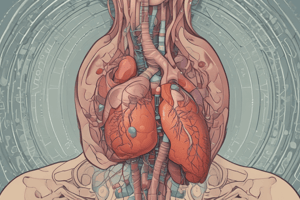Podcast
Questions and Answers
What is the primary function of the small intestine?
What is the primary function of the small intestine?
- Digestion of starches and fats
- Absorption of nutrients into the blood (correct)
- Production of digestive enzymes
- Regulation of blood sugar levels
What are the three sections of the small intestine?
What are the three sections of the small intestine?
- Ascending, Transverse, Descending
- Gastric, Pyloric, Cardiac
- Cecum, Colon, Rectum
- Duodenum, Jejunum, Ileum (correct)
Which of the following symptoms is commonly associated with colorectal cancer?
Which of the following symptoms is commonly associated with colorectal cancer?
- Bloody stools (correct)
- Nausea and vomiting
- Recurring migraines
- Severe abdominal pain
What factors are known to contribute to the development of Crohn's disease?
What factors are known to contribute to the development of Crohn's disease?
What is a major cause of appendicitis?
What is a major cause of appendicitis?
What is one of the symptoms of gastritis?
What is one of the symptoms of gastritis?
How does the structure of the small intestine aid in nutrient absorption?
How does the structure of the small intestine aid in nutrient absorption?
Which of the following best describes stomach ulcers?
Which of the following best describes stomach ulcers?
What is the primary function of Brunner’s glands in the small intestine?
What is the primary function of Brunner’s glands in the small intestine?
What are common signs and symptoms of Crohn’s disease?
What are common signs and symptoms of Crohn’s disease?
How does Crohn’s disease typically affect the gastrointestinal tract?
How does Crohn’s disease typically affect the gastrointestinal tract?
Which of the following is NOT a function of the large intestine?
Which of the following is NOT a function of the large intestine?
What is a common cause of appendicitis?
What is a common cause of appendicitis?
What is one suspected contributing factor to the development of Crohn’s disease?
What is one suspected contributing factor to the development of Crohn’s disease?
What is a potential symptom of colorectal cancer?
What is a potential symptom of colorectal cancer?
What tissue changes can occur due to Crohn's disease?
What tissue changes can occur due to Crohn's disease?
Which of the following is a cause of hepatitis?
Which of the following is a cause of hepatitis?
What are common signs of hepatitis?
What are common signs of hepatitis?
What triggers the gallbladder to eject bile?
What triggers the gallbladder to eject bile?
Which of the following is a common symptom of cholecystitis?
Which of the following is a common symptom of cholecystitis?
What are gallstones primarily composed of?
What are gallstones primarily composed of?
What role do acini cells in the pancreas play?
What role do acini cells in the pancreas play?
What is a potential effect of overusing acetaminophen on the liver?
What is a potential effect of overusing acetaminophen on the liver?
Where is the gallbladder located?
Where is the gallbladder located?
Flashcards are hidden until you start studying
Study Notes
Hepatitis
- Hepatitis is liver inflammation caused by infections (bacterial, viral, parasitic), alcohol abuse, drug abuse, and contaminated food.
- Common signs include enlarged liver, jaundice (yellowing skin/eyes), abdominal pain, nausea, vomiting, weakness, and dark urine.
Gallbladder
- Located between lobes of the liver in the right upper quadrant.
- Functions to store bile; contracts under cholecystokinin to release bile into the small intestine for digesting fats.
- Cholecystitis, the inflammation due to cystic duct blockage by gallstones, presents with recurring colicky pain in the right upper quadrant, possibly referred to the right scapula.
Gallstones
- Formed from solidified bile salts, phospholipids, and cholesterol.
Pancreas
- Situated posterior to the stomach, serving dual functions as an endocrine and exocrine gland.
- Comprises approximately 99% acini cells for exocrine secretion and 1% islets of Langerhans for endocrine functions.
- Acini cells secrete pancreatic lipase (fat breakdown) and pancreatic amylase (carbohydrate breakdown).
Stomach Diseases
- Common diseases include gastritis, stomach ulcers, and stomach cancer.
Gastritis
- Inflammation of the stomach lining caused by infections, medications, alcohol, stress, or spicy foods.
- Symptoms: upset stomach, nausea, vomiting, and heartburn.
Stomach Ulcers
- Erosions of the stomach lining, potentially leading to bleeding, often caused by Helicobacter pylori, excessive hydrochloric acid, smoking, alcohol, and chronic aspirin use.
- Symptoms include severe abdominal pain, nausea, potential weight loss, and vomiting with possible blood (red or coffee grounds appearance).
Stomach Cancer
- Exact causes are unknown, though stomach ulcers may contribute.
- Symptoms: bloating, gas, abdominal pain, cramping, bloody stool, nausea, and vomiting.
Small Intestine
- Muscular tube from the stomach to the large intestine’s cecum, primarily responsible for nutrient absorption.
- Divided into three sections: duodenum, jejunum, and ileum.
- Contains microvilli for increased absorption surface area, Brunner’s glands for alkaline mucus secretion, and crypts of Licherkühn for digestive enzymes.
Disorders of the Small Intestine
- Crohn’s disease (regional enteritis) is a chronic inflammatory condition affecting the mucosa, potentially leading to inflammation, ulceration, and intestinal stenosis.
- Symptoms: abdominal pain, cramping, fever, diarrhea, weight loss, and decreased red blood cell production due to malabsorption.
- Crohn's can affect any gastrointestinal area and has unknown causes, with possible familial and autoimmune links.
Large Intestine
- Functions in water, ion, and vitamin absorption and feces formation, expelling waste materials.
- Diseases include appendicitis, colorectal cancer, diverticulosis, hemorrhoids, and ulcerative colitis.
Studying That Suits You
Use AI to generate personalized quizzes and flashcards to suit your learning preferences.




